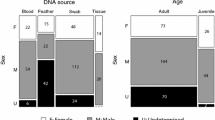Summary
Males outnumbered females as juveniles but not as adults among mice captured by hand in their burrows. The higher production of male offspring together with their higher mortality rate resulted in a 1∶1 sex ratio for the adult mice. Despite the equal abundance of each sex, more males than females were caught in traps. Males must have a higher chance of encountering a trap and/or of entering a trap after finding it.
Similar content being viewed by others
References
Blair, W. F. (1951) Population structure, social behavior, and environmental relations of the beach mouse (Peromyscus polionotus leucocephalus).Contrib. Lab. Vert. Biol. Univ. Mich. 48: 1–47.
Davenport, L. B., Jr. (1964) Structure of twoPeromyscus polionotus populations in old-field ecosystems at the AEC Savannah River Plant.J. Mammal. 45: 95–113.
Laffoday, S. K. (1957) A study of prenatal and postnatal development in the old field mouse,Peromyscus polionotus. Unpubl. Ph. D. diss., Univ. Florida, 101 pp.
Kang, Y. S. andW. K. Cho (1959a) Data on the biology of Korean populations.Human Biol. 31: 224–251.
Kang, Y. S. andW. K. Cho (1959b) The sex ratio at birth of the Korean population.Eugenic Quart. 6: 187–195.
Russell, W. T. (1936) Statistical study on the sex ratio at birth.J. Hyg. 36: 381–401.
Smith, M. H. (1966) The evolutionary significance of certain behavioral, physiological, and morphological adaptations of the old-field mouse,Peromyscus polionotus. Unpubl. Ph. D. diss., Univ. Florida, 186pp.
Smith, M. H. Reliability of the mark-release technique of estimating numbers of mice. Submitted for publication.
Smith, M. H. andW. C. Criss (1967) Effects of social behavior, sex, and ambient temperature on the endogenous diel body temperature cycle of the old-field mouse,Peromyscus polionotus.Physiol. Zool. 40: 31–39.
Steel, R. G. andJ. H. Torrie (1960) Principles and procedures of statistics. McGraw-Hill Book Co., Inc., New York.
Tanton, M. T. (1965) Problems of live-trapping and population estimation for the wood mouse,Apodemus sylvaticus (L).J. Anim. Ecol. 34: 1–22.
Williams, R. G., J. L. Carmon andF. B. Golley (1965) Reproductive performance of a laboratory colony ofPeromyscus polionotus.Amer. Midl. Nat. 73: 101–110.
Author information
Authors and Affiliations
Rights and permissions
About this article
Cite this article
Smith, M.H. Sex ratios in laboratory and field populations of the old field mouse,Peromyscus polionotus . Res Popul Ecol 9, 108–112 (1967). https://doi.org/10.1007/BF02514918
Issue Date:
DOI: https://doi.org/10.1007/BF02514918




